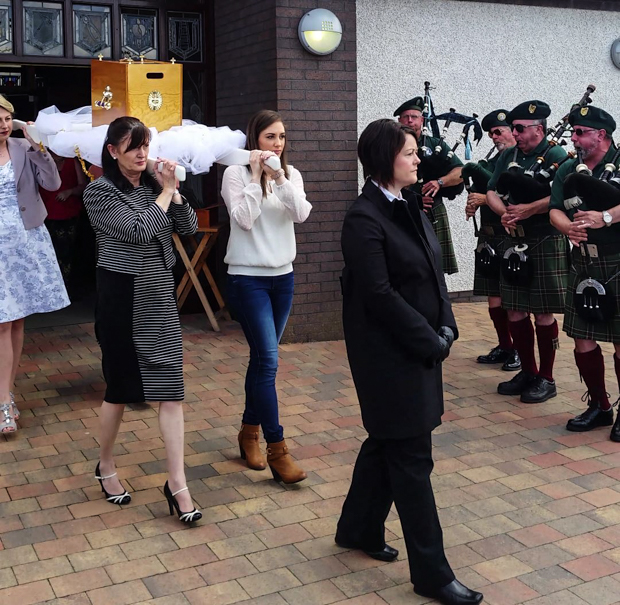
Catherine Burns’ remains are carried by women named Catherine from Clonoe, County Tyrone. The Watson brothers are at right, playing the pipes. Photo by Jim McArdle
On Sunday, July 19, Catherine Burns’s small casket, holding what little remained of the 29-year-old widow who died in the railroad work camp known as Duffy’s Cut in 1832, was carried from St. Patrick’s Church in Clonoe, County Tyrone, to her final resting place by three local women also named Catherine.
For 180 years, Burns lay under the ground in an unmarked grave along with 56 other Irish immigrants hired to build a rail line near Malvern in Chester County, now part of Amtrak’s northeast corridor. She had traveled with her father-in-law on the barque ship, the John Stamp, whose log noted that neither had any luggage. Six weeks after the immigrants arrived from Tyrone, Derry, and Donegal, they were dead, either of cholera or of violence.
Her burial in her home county was the fulfillment of the goal of the men who unearthed these long-forgotten immigrants, both literally and figuratively. “It was something that we had always hoped to do,” says Dr. William Watson, a history professor at Immaculata University who, with his brother Frank, a Lutheran minister, set in motion the search for the Duffy’s Cut victims after discovering a secret railroad file about the incident in their grandfather’s papers. “Once we found them, if we were able to identify them, we wanted to repatriate them,” he said.
In 2013, the Watson brothers and colleague Earl Schandlemeier were able to return the remains of the youngest of the workers, John Ruddy—identified through a forensic examination of his bones—to Donegal, where he was born. He is now buried in the family plot of Vincent Gallagher, president of the Philadelphia Irish Center.
Like Ruddy, forensic scientists determined that Catherine Burns had died of blunt force trauma, likely at the hands of a group of vigilantes determined to stop the spread of cholera that had ravaged the small encampment.
That story, as well known now in Ireland as in the US, is likely what filled St. Patrick’s Church the Sunday of Catherine Burns’ funeral mass, which was said by the church’s pastor, Father Benny Fee. “The story resonates with a lot of Irish people who have little black holes in their family history, family members who came here and just vanished,” said Watson. ‘They have sympathy for anyone that young who experienced such hardship so senselessly. Catherine Burns died just like John Ruddy died, of violence.”
It was Father Fee’s idea to have Catherine Burns’ casket carried by other women of the parish who shared her first name, said Watson. “His sermon was fantastic,” he said.
“It is our solemn privilege to welcome home to her native Tyrone Catherine’s mortal remains and to lay them to rest with the prayers and rites of the church and with the dignity and respect they deserve,” Father Fee told the congregation, according to published accounts. “Catherine is one of our own. She’s no stranger—she has Tyrone blood in her veins.”
From his pulpit, Father Fee thanked the Watsons and Schandlemeier for bringing “Catherine back from her exile to her native pastures. Now there’s no fear, no terror for Catherine any more.”
There are still 50 other victims of Duffy’s Cut whose bodies have not been recovered. Radar imaging has found what Watson calls “an anomaly,” a large apparently empty space that may have been left when bodies buried underground decomposed and collapsed. Core samples of that area are scheduled to be taken in mid-August, he said.
The cores will be taken about five feet from where the anomaly is seen on the scan so as not to disturb anything buried below. Forensic scientists will then sift through the circular samples, which will be encased in canisters about a foot long and four feet wide, to determine if there are any human remains before a dig gets underway.
“If what we find what we expect to find,” said Watson, “this maybe the worst mass murder in Pennsylvania history.”
The photos below were taken by Jim McArdle, who was one of several representatives from the Philadelphia area who attended the funeral service. The others included Irish Center President Vincent Gallagher, Donegal Association President Frank McDonnell and his wife, Kathleen, and Donegal Association members Nora and Liam Campbell and John Durnin.
[flickr_set id=”72157656136757130″]

